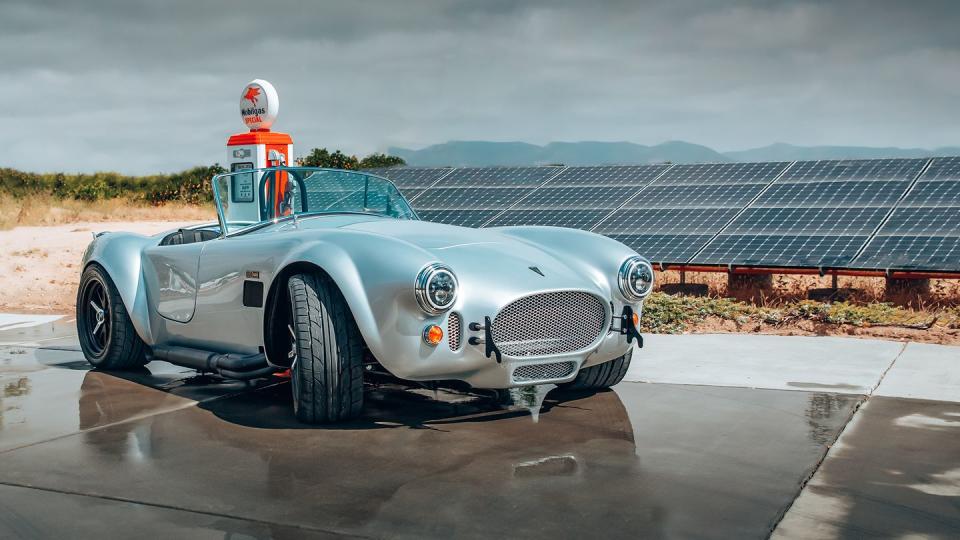Everyone Has the Wrong Idea About EV-Converted Classic Cars


EV conversions of classic cars are hotter than the UK this past August. It seems many people are drawn to the the style and the steel of an old car; the aesthetic that many egg-shaped crossovers can’t match thanks to pesky safety regulations and aerodynamic targets. But, at least in my city, the shine is wearing off on old powertrains. And I get it! Traffic is getting worse and worse. I have a variety of old cars myself, but there are lots of places and times I don’t want to drive them. Heat, the stress of stop and go traffic, not giving the engines a real chance to be used for what they are meant for, the frustration of traffic lights every eighth mile -- all are reasons for me to leave the 30-year old Ferrari in the garage and jump in my electric Ford Mach-E, a car that seems optimized for sitting in Los Angeles traffic, with its silent torque band and one-pedal driving system. Why shouldn’t you take the best parts of an EV, the smoothness, the lack of strain on a driveline, and apply that to something a little… prettier?
In my other job as CEO of Westside Collector Car Storage in Playa Vista, CA, I’ve been approached by clients no less than a dozen times over the last six months, inquiring about converting an old car to electric. What kind of power and range would they expect? How much does it cost? Who will do it?
The answers to all these questions vary, but as a general rule, an EV conversion can cost $40,000-$100,000 if you provide an excellent donor car. Based on the popularity of EV hot rodding in CA in 2022, expect to wait six to 12 months before a reputable shop will even touch your car, and then the same six to 12 months again to get the job done. Maybe a bit less if it’s a more commonly swapped car, and maybe more if it’s a unique project.
Most basic setups can provide a reliable 150 miles of range if driven gingerly, but there are a lot of variables, including the size, shape, and weight of the car, and how many batteries can be fit and where. If your basic project car is rusty, or otherwise in rough shape, double the timeline, and double the cost. After all, there is a lot of work to be done even in a best-case scenario. Motors recycled from Teslas can provide anywhere from 300 to 600 horsepower to a single axle, often far, far more than the car left the factory with.

Some companies, such as Temecula’s Scorpion EV, will sell turn key examples of EV-rodded classics, such as the Cobra Replica I’ve just driven on a hot Malibu Monday. It makes 600 horsepower and almost 700 lb-ft of torque to the rear wheels, weighs 2600 pounds, and pairs a reasonably polished, well-programmed, single-speed EV powertrain with a Factory Five Cobra chassis, body, and interior, for $185,000 out the door and a six-week turnaround, painted any color you like. You can adjust the power output up and down on the fly, you can dial the regenerative braking on or off, and it even uses an electronic parking brake. It’s a pretty neat package. It can walk an original Cobra in the quarter mile, and will easily light up the tires at low speeds in a muted burnout. There is an argument that everything about this car is objectively “better” than either an original Shelby Cobra or a well-built replica. But it left me nonplussed, and moderately bored.

Almost all conversions use Tesla powertrains and batteries. Why? Because people crash a LOT of Teslas, meaning the supply of batteries and motors is plentiful. No argument from me - I may criticize a lot of things about Tesla, but their motors work just fine and their batteries (actually supplied by Panasonic, but that doesn’t sound as sexy as “Tesla-Powered”) are better off recycled into an old car than in a landfill. As more OEMs produce mass market EVs, we can probably expect a variety of options to become available, depending on a patron’s specific needs.
But here’s the question: Should you bother with an EV conversion at all? Does it give new life to an old sports car? Does it actually improve things? Having now driven a variety of different converted classics, my answer is: “It depends.”

 Yahoo Autos
Yahoo Autos 